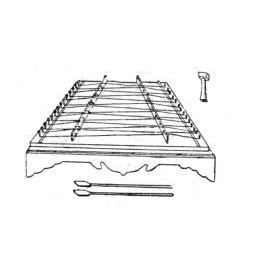Chong's reforms
Qiang continues to move forward with the advancement of society.

In the 1930s, the first generation of qiang was composed of two horses, three rows of tones, seven-tone scale arrangement, and twenty-one tones. The front length of the piano box was 81.8 cm, the back length was 99 cm, the width was 35.2 cm, and the middle height was 9 cm. .
In the late 1950s, Asimu, an old man of Uyghur ethnicity in Urumqi, reformed into the second generation of Qiang, with two stripes of horses, three rows of sounds, the phonemes arranged in a vertical minor second and a horizontal fifth, with thirty-four phonemes and complete semitones. Range g-e3.
Since then, on the basis of the second generation of qiang, there has been a reformed qiang with enlarged body, wider string spacing, and maintaining two rows of horses. The pronunciation is both crisp and loud.
After the 1960s, the mutated dulcimer with four stripes, six rows and four ranges, which was reformed and developed by Yang Jingming of the China Central Broadcasting National Orchestra and Beijing National Musical Instrument Factory, has been widely used in various art groups in Xinjiang. Its sound box has a front length of 78 cm, a rear length of 118 cm, a width of 51 cm, and a middle height of 8 cm.
The skeleton of the Qiangqin made in Xinjiang adopts a metal structure, and the inner cavity is equipped with toothed sound beams and horizontal lining strips, and aluminum rollers and roller strips are added to the panel, which overcomes the dry climate in Xinjiang, rapid temperature changes, and other components. Defects such as body bending deformation and easy running of strings increase the brightness and volume of the timbre.
The phonemes of the yangqin we have used so far are based on the phoneme arrangement of the yangqin of the mutated dulcimer, and refer to the phoneme of the twelve well-tempered dulcimer in Guangzhou, which was reformed in the 1970s. Play a temporary change of semitones.
 渝公网安备 50010702504639号
渝公网安备 50010702504639号